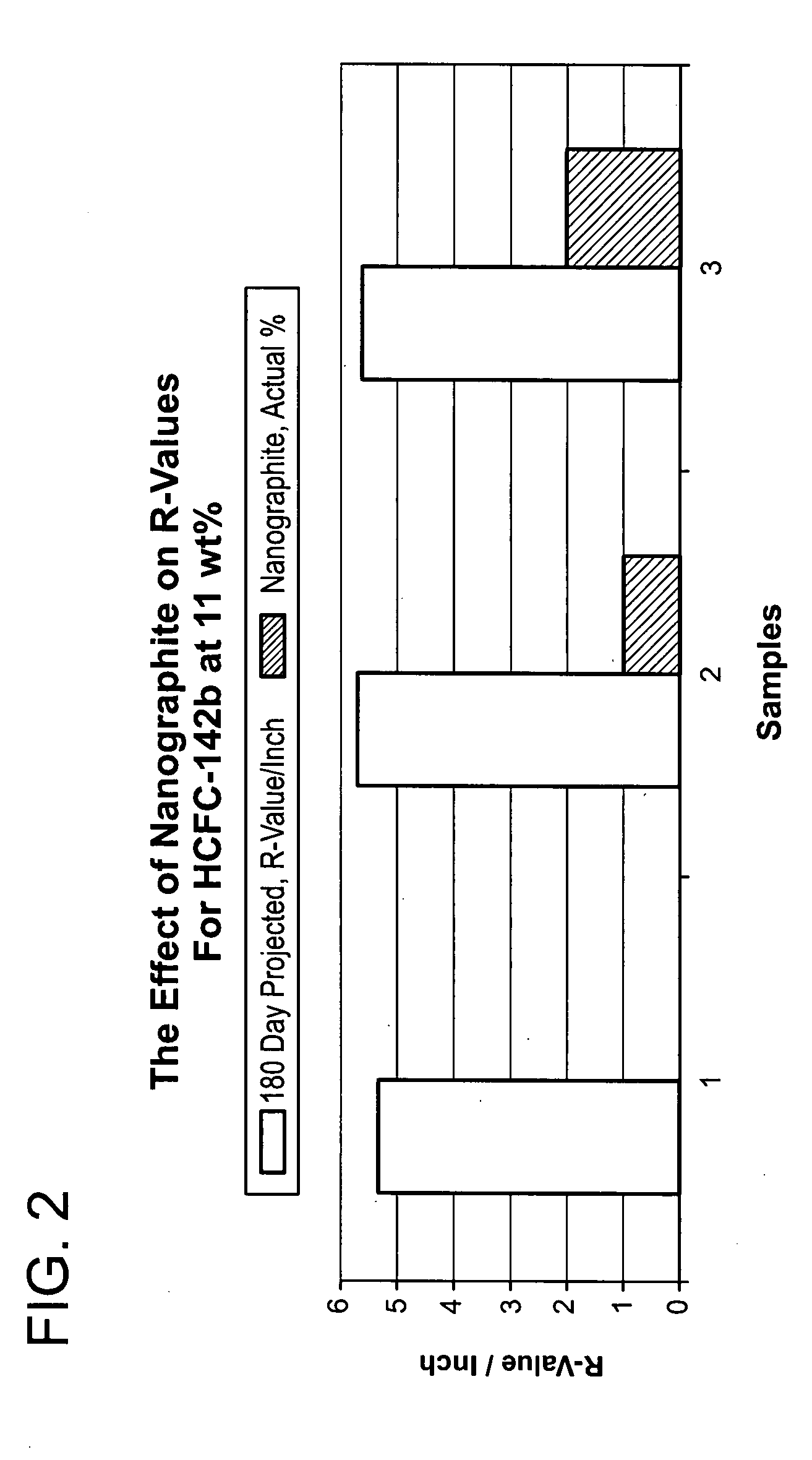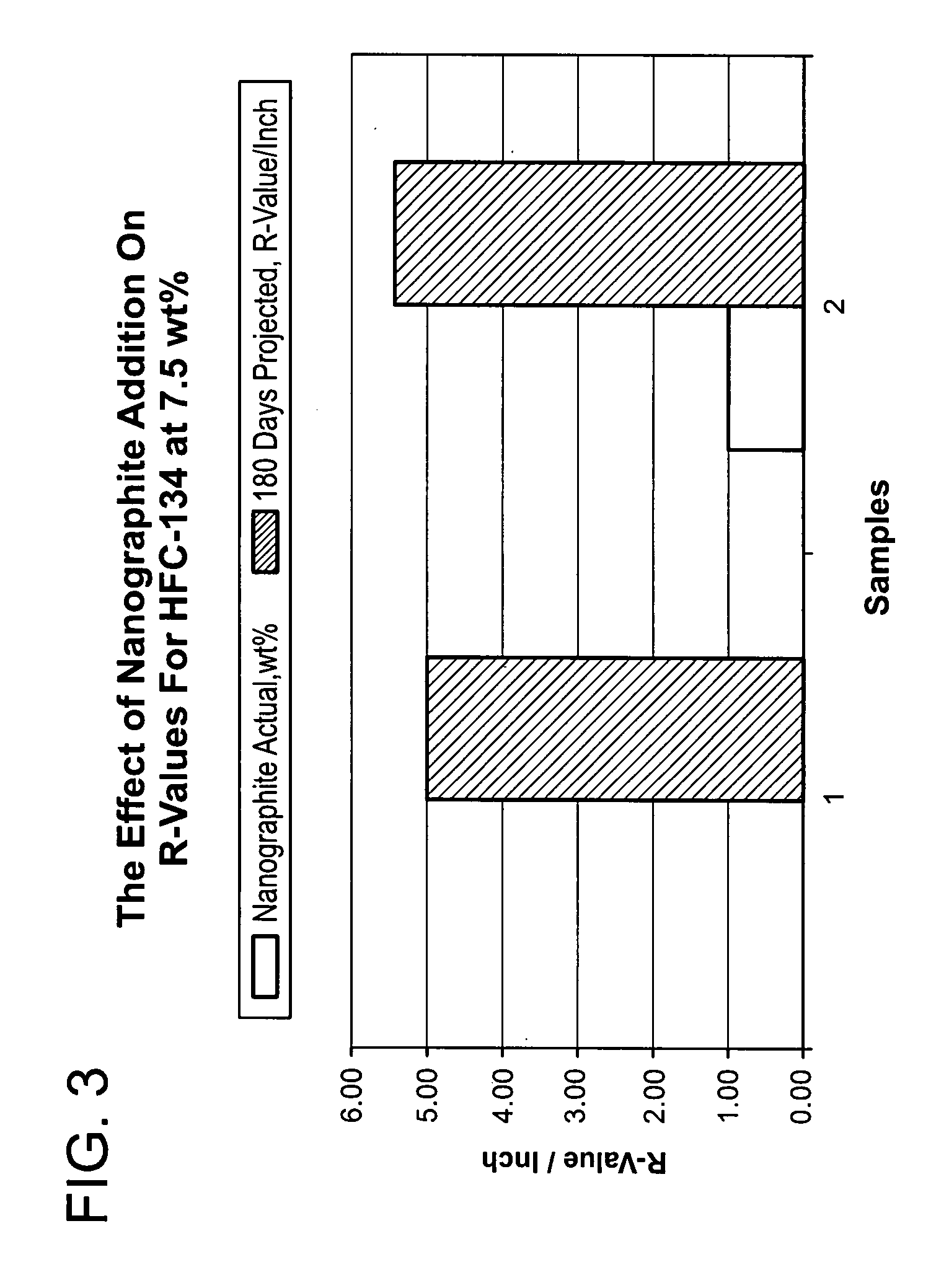Polystyrene foams incorporating nanographite and HFC-134
a polystyrene foam and nanographite technology, applied in the field of polystyrene foam, can solve the problems of reducing the insulative value of the foam, and potentially contributing to the global warming potential, and achieves less blowing agent, high r-value, and increased r-value of the foam board
- Summary
- Abstract
- Description
- Claims
- Application Information
AI Technical Summary
Benefits of technology
Problems solved by technology
Method used
Image
Examples
example 1
Comparison of Foam Board R-values For HCFC-142b and HFC-134 Containing No Nanographite
[0062]Compositions containing polystyrene, either 1,1,2,2-tetrafluoroethane (HFC-134) or 1-chloro-1,1-difluoroethane (HCFC-142b), and talc as depicted in Table 1 were formed according to the extrusion method described in detail above. In particular, the polystyrene and talc were heated to a melt mixing temperature of 150° C.-180° C. to form a melt polymer material. 1,1,2,2-tetrafluoroethane was then mixed into the polymer melt at a first pressure from 210-230 bars to generally disperse the blowing agent homogeneously in the melt polymer material and form a foamable gel. The foamable gel was then cooled to a temperature from 125° C.-135° C. The foamable gel was extruded in a twin screw extruder and through a die to a zone of reduced pressure (14.0 psi absolute-5.0 psi absolute) to produce the rigid foam boards. As used in the examples, the phrase “% by weight” is the % by dry weight of the component...
example 2
Effect of Nanographite on R-Values for Foamed Boards Formed with 11 wt % HCFC-142b
[0066]Compositions containing polystyrene, 1-chloro-1,1-difluoroethane (HCFC-142b), and nanographite as depicted in Table 4 were formed according to the extrusion method described in detail above. In particular, the polystyrene and nanographite were heated a melt mixing temperature of 150° C.-180° C. to form a melt polymer material. 1-chloro-1,1-difluoroethane was then mixed into the polymer melt at a first pressure from 210-230 bars to generally disperse the 1-chloro-1,1-difluoroethane homogeneously in the melt polymer material and form a foamable gel. The foamable gel was then cooled to a temperature from 125° C.-135° C. (the die melt temperature). The foamable gel was extruded in a twin screw extruder and through a die to a zone of reduced pressure (14.0 psi absolute-5.0 psi absolute) to produce the rigid foam boards. The process conditions are set forth in Table 4.
TABLE 4Compositions of Foamed Boar...
example 3
Effects of Nanographite on R-Values for Foamed Boards Formed with 7.5 wt % HFC-134
[0069]Compositions containing polystyrene, 1,1,2,2-tetrafluoroethane (HFC-134), and nanographite as depicted in Table 5 were formed according to the extrusion method described in detail above. In particular, the polystyrene and nanographite were heated a melt mixing temperature of 150° C.-180° C. to form a melt polymer material. 1,1,2,2-tetrafluoroethane (HFC-134) was then mixed into the polymer melt at a first pressure from 210-230 bars to generally disperse the 1,1,2,2-tetrafluoroethane homogeneously in the melt polymer material and form a foamable gel. The foamable gel was then cooled to a temperature from 125° C.-135° C. (the die melt temperature). The foamable gel was extruded in a twin screw extruder and through a die to a zone of reduced pressure (14.0 psi absolute-5.0 psi absolute) to produce the rigid foam boards. The process conditions are set forth in Table 6.
TABLE 6Compositions of Foamed Bo...
PUM
| Property | Measurement | Unit |
|---|---|---|
| Fraction | aaaaa | aaaaa |
| Fraction | aaaaa | aaaaa |
| Percent by mass | aaaaa | aaaaa |
Abstract
Description
Claims
Application Information
 Login to View More
Login to View More - R&D
- Intellectual Property
- Life Sciences
- Materials
- Tech Scout
- Unparalleled Data Quality
- Higher Quality Content
- 60% Fewer Hallucinations
Browse by: Latest US Patents, China's latest patents, Technical Efficacy Thesaurus, Application Domain, Technology Topic, Popular Technical Reports.
© 2025 PatSnap. All rights reserved.Legal|Privacy policy|Modern Slavery Act Transparency Statement|Sitemap|About US| Contact US: help@patsnap.com



